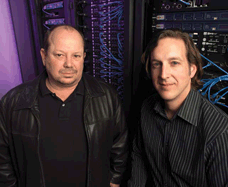- ORLANDO, FL—Seeing will be believing at InfoComm when Harman Professional, Broadcom, XMOS, and Meyer Sound demonstrate the IEEE 802.1 Audio/Video Bridging (AVB) Task Group work, delivering uninterrupted audio and video over standards-based ethernet. With the demonstration, the group will celebrate the unique achievement of sending time-synchronized, low-latency audio and video over ethernet with “perfect Quality of Service” (QoS).
- “It’s been a long journey for us these last three and a half years, and we’re excited to show the results
Robert Boatright (left), director of research for Harman International and chair of the IEEE 1722 AVB Transport Protocol Working Group, and Rick Kreifeldt, Harman SDIG vice president. of our efforts,” said Rick Kreifeldt, vice president, Harman System Development and Integration Group (SDIG). The IEEE 802 working groups, a coalition of technology companies from professional audio and video, semiconductor, networking, computing, and consumer electronics fields, have been working on protocols that allow the building of standards-based networks with the appropriate QoS for high-quality audio performance and production.
Following a much-discussed preview at the ProLight+Sound show in Frankfurt, Germany this past April, AVB will make its official debut at InfoComm this month. In addition to the demo, which according to Kreifeldt will prove “that there’s real silicon, it’s in products, and it’s working,” a major AVB announcement will be made at the show. The news was still under wraps at press time.
AVB’s arrival marks a somewhat rare occasion when consumer and IT lead to immediate commercial AV gain. “In the world where this is going to be big, outside of this industry in the automotive and consumer markets, it’s all about the ‘V’,” Kreifeldt explained. But of course video is a strong driver in the commercial installation world as well, where, Kreifeldt pointed out, “Even in a small church or a small auditorium where they want IMAG, the question has always been how do you get there under one infrastructure, one backbone. That’s why for us this has been such a big deal. Obviously this is a unique opportunity because something from outside the pro audio industry has come in that gives us a way to do new products and add new features that can really change our world.”
AVB retains 100 percent compatibility with legacy ethernet networks, but the technology will also “enable networking in places it’s never gone,” Kreifeldt said. “Because it’s going into products it’s never gone into, and as a result it will go into jobs it’s never gone into. Many contractors have never been able to realize the benefits of getting rid of all that excess cabling and conduit—the significant labor savings have not yet hit the mass market.”
Using USB’s ease of use as a point of comparison, Kreifeldt went on to say that “with AVB, rather than having to go in and configure networks, we’re talking about smart devices and smart switchers that negotiate amongst themselves.”
Noting that with its introduction of HiQnet, Harman was one of the first manufacturers to offer a singlepipe solution with control and audio down the same track, Kreifeldt described the goal of the company’s participation in the AVB Task Group: “All these islands of manufacturers having their own thing, that doesn’t help the industry. We want the industry to go in this direction because it’s good for all of us.”
